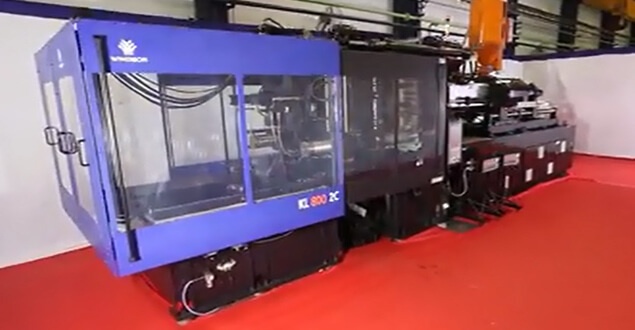Introduction
Plastic injection molding machines have revolutionized the manufacturing industry, enabling the mass production of high-quality plastic components with precision and efficiency. From automotive parts to household goods, these machines play a crucial role in modern industrial processes. In this comprehensive guide, we will explore what plastic injection molding machines are, how they work, their types, advantages, applications, and key considerations when choosing the right machine for your needs.
What is a Plastic Injection Molding Machine?
A plastic injection molding machine is a device used to manufacture plastic products by injecting molten plastic into a mold. The machine consists of several key components, including an injection unit, clamping unit, mold, and control system. This process allows manufacturers to create complex plastic parts with high accuracy and minimal waste.
How Does a Plastic Injection Molding Machine Work?
The operation of a plastic injection molding machine follows a series of steps:
- Material Feeding – Thermoplastic pellets are fed into the machine’s hopper.
- Melting – The pellets are heated in the barrel to reach a molten state.
- Injection – The molten plastic is injected into a mold cavity under high pressure.
- Cooling – The plastic cools and solidifies, taking the shape of the mold.
- Ejection – The finished product is ejected from the mold and the process repeats.
Types of Plastic Injection Molding Machines
Plastic injection molding machines come in various types, each catering to specific manufacturing needs. The main types include:
1. Hydraulic Injection Molding Machines
These machines use hydraulic systems to control the injection and clamping force. They are widely used due to their robustness and ability to handle large-scale production.
Pros:
- High clamping force
- Suitable for heavy-duty applications
- Cost-effective for large parts
Cons:
- Higher energy consumption
- Requires regular maintenance
2. Electric Injection Molding Machines
Electric machines use servo motors instead of hydraulic systems, providing precise control over the molding process.
Pros:
- Energy-efficient
- Faster cycle times
- Low maintenance
Cons:
- Higher initial investment
- Limited in high-pressure applications
3. Hybrid Injection Molding Machines
Hybrid machines combine hydraulic and electric systems, offering a balance of power and energy efficiency.
Pros:
- Improved energy efficiency compared to hydraulic machines
- High precision and faster cycle times
- Versatile for different applications
Cons:
- More expensive than hydraulic machines
- Complex maintenance
4. Vertical Injection Molding Machines
These machines operate with a vertical clamping mechanism, ideal for insert molding applications.
Pros:
- Space-saving design
- Suitable for over-molding and insert molding
Cons:
- Limited to specific applications
Advantages of Plastic Injection Molding Machines
Using plastic injection molding machines offers several advantages in the manufacturing industry:
- High Efficiency & Speed – Once set up, injection molding allows for rapid production cycles.
- Precision & Consistency – Capable of producing highly detailed and complex parts with minimal variations.
- Cost-Effective for Mass Production – Low per-unit cost when producing large quantities.
- Wide Range of Material Compatibility – Can process various thermoplastics, including ABS, polypropylene, and polyethylene.
- Minimal Waste – Excess plastic can be recycled and reused.
- Automation & Scalability – Fully automated systems improve productivity and reduce labor costs.
Applications of Plastic Injection Molding Machines
Plastic injection molding machines are used in a variety of industries due to their versatility and efficiency:
1. Automotive Industry
- Production of bumpers, dashboards, and interior components.
- High precision and durability for automotive applications.
2. Medical Industry
- Manufacturing of syringes, medical device casings, and surgical instruments.
- High hygiene standards and biocompatible materials.
3. Consumer Goods
- Household items like containers, chairs, and toys.
- Cost-effective production of everyday plastic products.
4. Electronics Industry
- Components such as connectors, enclosures, and switches.
- High accuracy for intricate electronic parts.
5. Packaging Industry
- Manufacturing of bottles, caps, and food containers.
- Ensures product safety and efficiency in mass production.
Key Considerations When Choosing a Plastic Injection Molding Machine
Selecting the right injection molding machine requires careful consideration of several factors:
1. Clamping Force
The clamping force determines the machine’s ability to keep the mold closed during injection. It is measured in tons and should be chosen based on the size and complexity of the product.
2. Injection Capacity
This refers to the amount of molten plastic that can be injected into the mold per cycle. It should match the product’s volume requirements.
3. Machine Size & Footprint
Consider the available space in your production facility and choose a machine that fits without compromising efficiency.
4. Energy Consumption
Energy efficiency plays a crucial role in operational costs. Electric and hybrid machines are more energy-efficient compared to hydraulic models.
5. Material Compatibility
Ensure the machine can process the specific type of plastic required for your application.
6. Automation & Integration
Modern machines come with robotic automation and advanced control systems for improved productivity.
7. Maintenance & Durability
Look for machines with easy maintenance features and reliable components to ensure longevity and minimize downtime.
Conclusion
Plastic injection molding machines are essential for producing high-quality plastic products across various industries. Understanding the different types, working principles, and key considerations can help businesses make informed decisions when investing in these machines. With advancements in technology, injection molding continues to evolve, providing manufacturers with efficient, cost-effective, and sustainable production solutions.
Whether you’re in the automotive, medical, consumer goods, or packaging industry, selecting the right plastic injection molding machine can significantly impact your production efficiency and overall business success.
Read More Blog – https://insighthubster.online/smart-alarm-clock/
